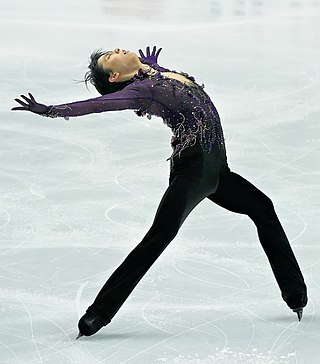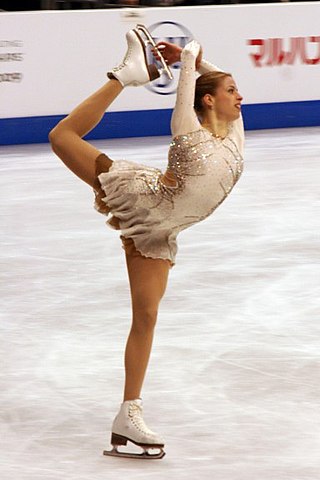
Figure skating is a sport in which individuals, pairs, or groups perform on figure skates on ice. It was the first winter sport to be included in the Olympic Games, with its introduction occurring at the 1908 Olympics in London. The Olympic disciplines are men's singles, women's singles, pair skating, and ice dance; the four individual disciplines are also combined into a team event, which was first included in the Winter Olympics in 2014. The non-Olympic disciplines include synchronized skating, Theater on Ice, and four skating. From intermediate through senior-level competition, skaters generally perform two programs, which, depending on the discipline, may include spins, jumps, moves in the field, lifts, throw jumps, death spirals, and other elements or moves.
Figure skating jumps are an element of three competitive figure skating disciplines: men's singles, women's singles, and pair skating – but not ice dancing. Jumping in figure skating is "relatively recent". They were originally individual compulsory figures, and sometimes special figures; many jumps were named after the skaters who invented them or from the figures from which they were developed. It was not until the early part of the 20th century, well after the establishment of organized skating competitions, when jumps with the potential of being completed with multiple revolutions were invented and when jumps were formally categorized. In the 1920s Austrian skaters began to perform the first double jumps in practice. Skaters experimented with jumps, and by the end of the period, the modern repertoire of jumps had been developed. Jumps did not have a major role in free skating programs during international competitions until the 1930s. During the post-war period and into the 1950s and early 1960s, triple jumps became more common for both male and female skaters, and a full repertoire of two-revolution jumps had been fully developed. In the 1980s men were expected to complete four or five difficult triple jumps, and women had to perform the easier triples. By the 1990s, after compulsory figures were removed from competitions, multi-revolution jumps became more important in figure skating.

Compulsory figures or school figures were formerly a segment of figure skating, and gave the sport its name. They are the "circular patterns which skaters trace on the ice to demonstrate skill in placing clean turns evenly on round circles". For approximately the first 50 years of figure skating as a sport, until 1947, compulsory figures made up 60 percent of the total score at most competitions around the world. These figures continued to dominate the sport, although they steadily declined in importance, until the International Skating Union (ISU) voted to discontinue them as a part of competitions in 1990. Learning and training in compulsory figures instilled discipline and control; some in the figure skating community considered them necessary to teach skaters basic skills. Skaters would train for hours to learn and execute them well, and competing and judging figures would often take up to eight hours during competitions.
Three figure skating events were contested at the 1920 Summer Olympics in Antwerp, but they were held in April 1920, four months before most of the other Olympic events at the 1920 Games. The figure skating competition took place at the Ice Palace of Antwerp.
The figure skating events at the 1972 Winter Olympics were held at the Makomanai Skating Rink and the Mikaho Indoor Skating Rink.

Figure skating was first contested in the Olympic Games at the 1908 Summer Olympics. Since 1924, the sport has been a part of the Winter Olympic Games.
The men's special figures was one of four events in figure skating at the 1908 Summer Olympics. Each nation could enter up to 3 skaters. Gold medalist Nikolai Panin's real name was Nikolai Kolomenkin, but he competed under the pseudonym "Panin".
The ladies' singles was one of four events in figure skating at the 1908 Summer Olympics. Each nation could enter up to 3 skaters. Without rivals Jenny Herz and Lily Kronberger present at the Olympics, Great Britain's Madge Syers easily won the gold medal.
The mixed pairs was one of four events in figure skating at the 1908 Summer Olympics. Each nation could enter up to 3 pairs. Twelve years later, silver medalist Phyllis Johnson would capture a bronze medal with a new partner at the 1920 Olympics.
The men's 10 metre platform, also known as the high diving competition, was one of two diving events on the diving at the 1908 Summer Olympics programme, along with the men's 3 metre springboard. The competition was held from Monday 20 to Friday 24 July 1908. Twenty-four divers from six nations competed. Each nation could enter up to 12 divers.
The men's 3 metre springboard, also known as the fancy diving competition, was one of two diving events on the Diving at the 1908 Summer Olympics programme, along with the men's 10 metre platform. The competition was held on Tuesday 14 and Saturday 18 July 1908. Twenty-three divers from eight nations competed. Each nation could enter up to 12 divers.
The ISU Judging System or the International Judging System (IJS), occasionally referred to as the Code of Points (COP) system, is the scoring system that has been used since 2004 to judge the figure skating disciplines of men's and ladies' singles, pair skating, ice dance, and synchronized skating. It was designed and implemented by the International Skating Union (ISU), the ruling body of the sport.
Horatio Tertuliano Torromé, also credited as Henri Torromé, was a British figure skater who also competed for Argentina.
The following is a glossary of figure skating terms, sorted alphabetically.

Single skating is a discipline of figure skating in which male and female skaters compete individually. Men's singles and women's singles are governed by the International Skating Union (ISU). Figure skating is the oldest winter sport contested at the Olympics, with men's and women's single skating appearing as two of the four figure skating events at the London Games in 1908.
The women's individual skating event held as part of the figure skating at the 1920 Summer Olympics. It was the second appearance of the event and the sport, which had previously been held in 1908.
The men's single skating competition of the 1960 Winter Olympics was held at the Blyth Arena in Squaw Valley, California, United States. The compulsory figures section took place on Wednesday 24 February 1960 with the free skating section concluding the event two days later. Each judge ranked each skater by Ordinal Placement from first to last place. If a skater was ranked first by a majority of the judges, that skater was placed first overall, this process was repeated for each place. If more than one skater had a majority ranking for the same position then a series of tiebreaks were in place, indicated in order in the result section.
The women's single skating competition of the 1960 Winter Olympics was held at the Blyth Arena in Squaw Valley, California, United States. The compulsory figures section took place on Sunday 21 February 1960 with the free skating section concluding the event two days later. Each judge ranked each skater by Ordinal Placement from first to last place. If a skater was ranked first by a majority of the judges, that skater was placed first overall, this process was repeated for each place. If more than one skater had a majority ranking for the same position then a series of tiebreaks were in place, indicated in order in the result section.
The pair skating competition of the 1960 Winter Olympics was held at the Blyth Arena in Squaw Valley, California, United States. The event took place on Friday 19 February 1960. Each judge ranked the skaters by Ordinal Placement from first to last place. If a skater was ranked first by a majority of the judges, that skater was placed first overall; this process was repeated for each place. If more than one skater had a majority ranking for the same position, then a series of tiebreaks were in place, indicated in order in the Results section below.

The 2019 World Figure Skating Championships were held in Saitama, Japan, from March 18–24, 2019.





